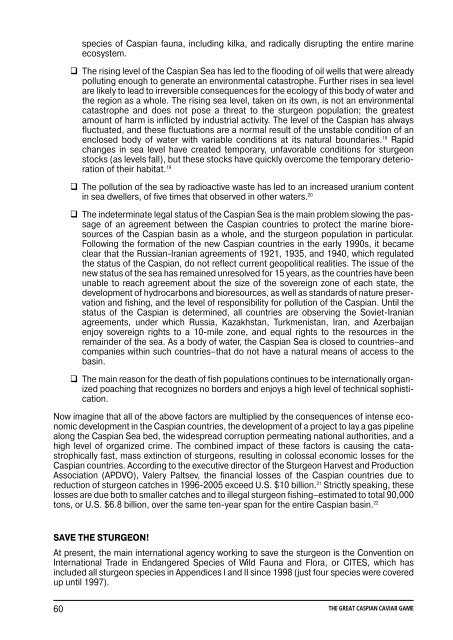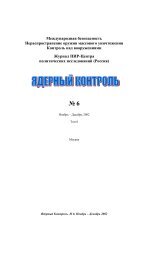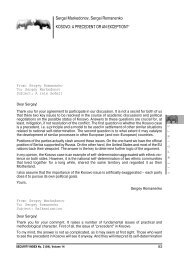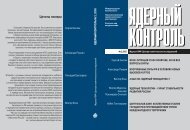Ekaterina Shadrina THE GREAT CASPIAN CAVIAR GAME
Ekaterina Shadrina THE GREAT CASPIAN CAVIAR GAME
Ekaterina Shadrina THE GREAT CASPIAN CAVIAR GAME
Create successful ePaper yourself
Turn your PDF publications into a flip-book with our unique Google optimized e-Paper software.
species of Caspian fauna, including kilka, and radically disrupting the entire marine<br />
ecosystem.<br />
The rising level of the Caspian Sea has led to the flooding of oil wells that were already<br />
polluting enough to generate an environmental catastrophe. Further rises in sea level<br />
are likely to lead to irreversible consequences for the ecology of this body of water and<br />
the region as a whole. The rising sea level, taken on its own, is not an environmental<br />
catastrophe and does not pose a threat to the sturgeon population; the greatest<br />
amount of harm is inflicted by industrial activity. The level of the Caspian has always<br />
fluctuated, and these fluctuations are a normal result of the unstable condition of an<br />
enclosed body of water with variable conditions at its natural boundaries. 18 Rapid<br />
changes in sea level have created temporary, unfavorable conditions for sturgeon<br />
stocks (as levels fall), but these stocks have quickly overcome the temporary deterioration<br />
of their habitat. 19<br />
The pollution of the sea by radioactive waste has led to an increased uranium content<br />
in sea dwellers, of five times that observed in other waters. 20<br />
The indeterminate legal status of the Caspian Sea is the main problem slowing the passage<br />
of an agreement between the Caspian countries to protect the marine bioresources<br />
of the Caspian basin as a whole, and the sturgeon population in particular.<br />
Following the formation of the new Caspian countries in the early 1990s, it became<br />
clear that the Russian-Iranian agreements of 1921, 1935, and 1940, which regulated<br />
the status of the Caspian, do not reflect current geopolitical realities. The issue of the<br />
new status of the sea has remained unresolved for 15 years, as the countries have been<br />
unable to reach agreement about the size of the sovereign zone of each state, the<br />
development of hydrocarbons and bioresources, as well as standards of nature preservation<br />
and fishing, and the level of responsibility for pollution of the Caspian. Until the<br />
status of the Caspian is determined, all countries are observing the Soviet-Iranian<br />
agreements, under which Russia, Kazakhstan, Turkmenistan, Iran, and Azerbaijan<br />
enjoy sovereign rights to a 10-mile zone, and equal rights to the resources in the<br />
remainder of the sea. As a body of water, the Caspian Sea is closed to countries–and<br />
companies within such countries–that do not have a natural means of access to the<br />
basin.<br />
The main reason for the death of fish populations continues to be internationally organized<br />
poaching that recognizes no borders and enjoys a high level of technical sophistication.<br />
Now imagine that all of the above factors are multiplied by the consequences of intense economic<br />
development in the Caspian countries, the development of a project to lay a gas pipeline<br />
along the Caspian Sea bed, the widespread corruption permeating national authorities, and a<br />
high level of organized crime. The combined impact of these factors is causing the catastrophically<br />
fast, mass extinction of sturgeons, resulting in colossal economic losses for the<br />
Caspian countries. According to the executive director of the Sturgeon Harvest and Production<br />
Association (APDVO), Valery Paltsev, the financial losses of the Caspian countries due to<br />
reduction of sturgeon catches in 1996-2005 exceed U.S. $10 billion. 21 Strictly speaking, these<br />
losses are due both to smaller catches and to illegal sturgeon fishing–estimated to total 90,000<br />
tons, or U.S. $6.8 billion, over the same ten-year span for the entire Caspian basin. 22<br />
SAVE <strong>THE</strong> STURGEON!<br />
At present, the main international agency working to save the sturgeon is the Convention on<br />
International Trade in Endangered Species of Wild Fauna and Flora, or CITES, which has<br />
included all sturgeon species in Appendices I and II since 1998 (just four species were covered<br />
up until 1997).<br />
60 <strong>THE</strong> <strong>GREAT</strong> <strong>CASPIAN</strong> <strong>CAVIAR</strong> <strong>GAME</strong>








